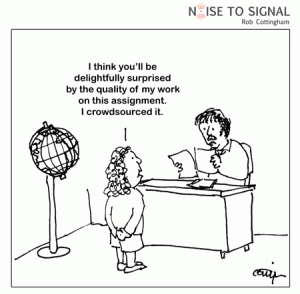Chapter three: Crowd-powered collaboration
In chapter three, Mark Briggs focuses on the new types of reporting methods that are becoming more prevalent in this day and age.
Crowdsourcing
Coined by Wired News’ Jeff Howe in 2006, this term basically means distributed reporting. It is using a lot of news sources at a given time to help research a specific story. The concept itself lends to grassroots organizations and projects such as InnoCentive and Amazon. According to Briggs, crowdsourcing aims a community power on a specific task and shows that a group of committed individuals can outperform a small group of experience and paid professionals that aren’t as committed.
Open-source reporting
This is a transparent way of obtaining news and showing off your news sources to the public. Due to open-source reporting, blogs and social media websites are important because they keep the media on their toes from making mistakes. And if they do make any errors, they can fix it with a click of a button. Open-source reporting welcomes the reader’s feedback and helps journalists increase their credibility and social capital.
Pro-am Journalism
This is the most unfiltered form of journalism on the web. Everyone is their own author and decides what to publish when and where. It is a do-it-yourself movement that made everyone want to play the role of journalist. The example that Briggs gives is CNN’s iReport. This platform enables users to upload and publish their own content to CNN’s stories as a local reporter. With this approach, everyone is a media outlet.
Happy reading folks.


